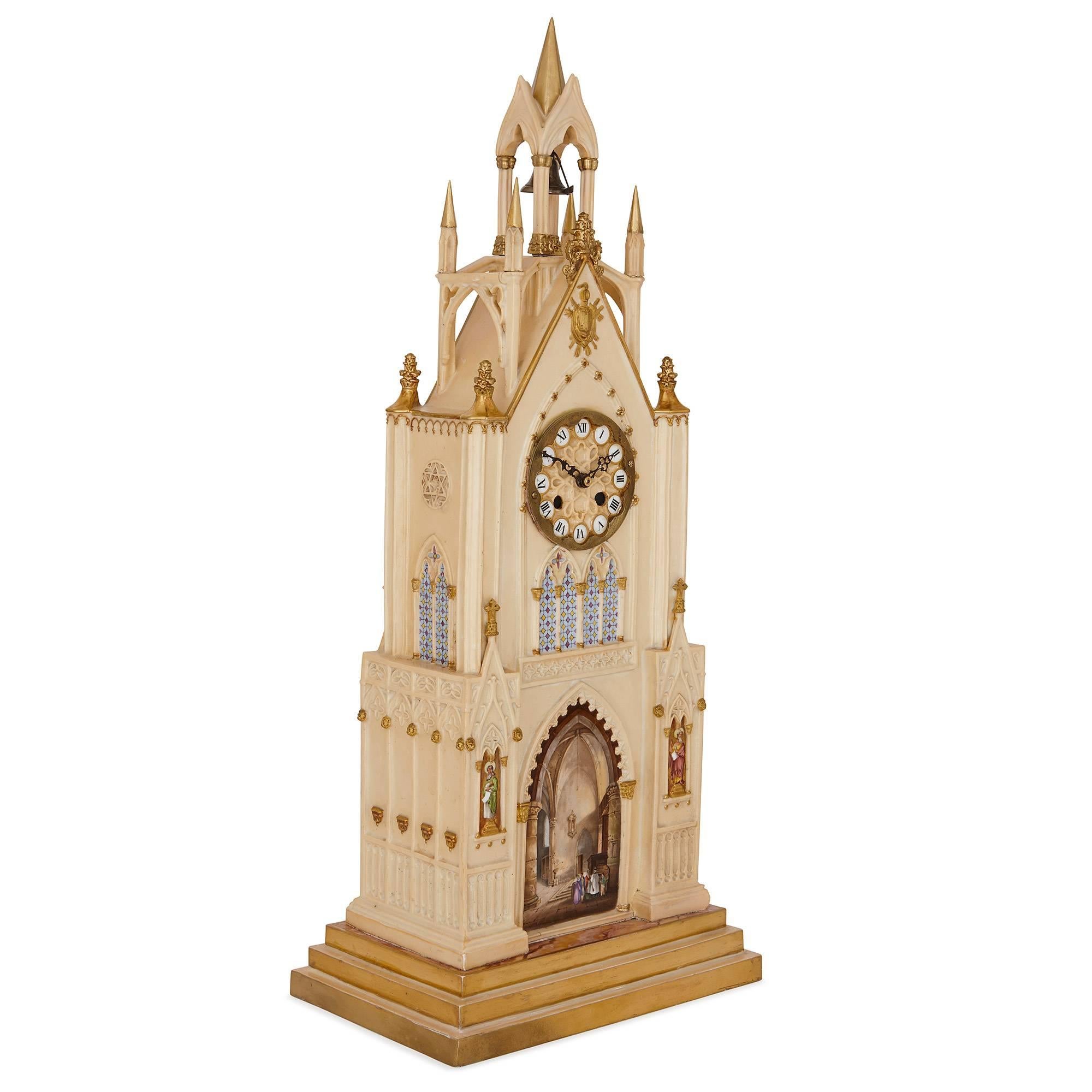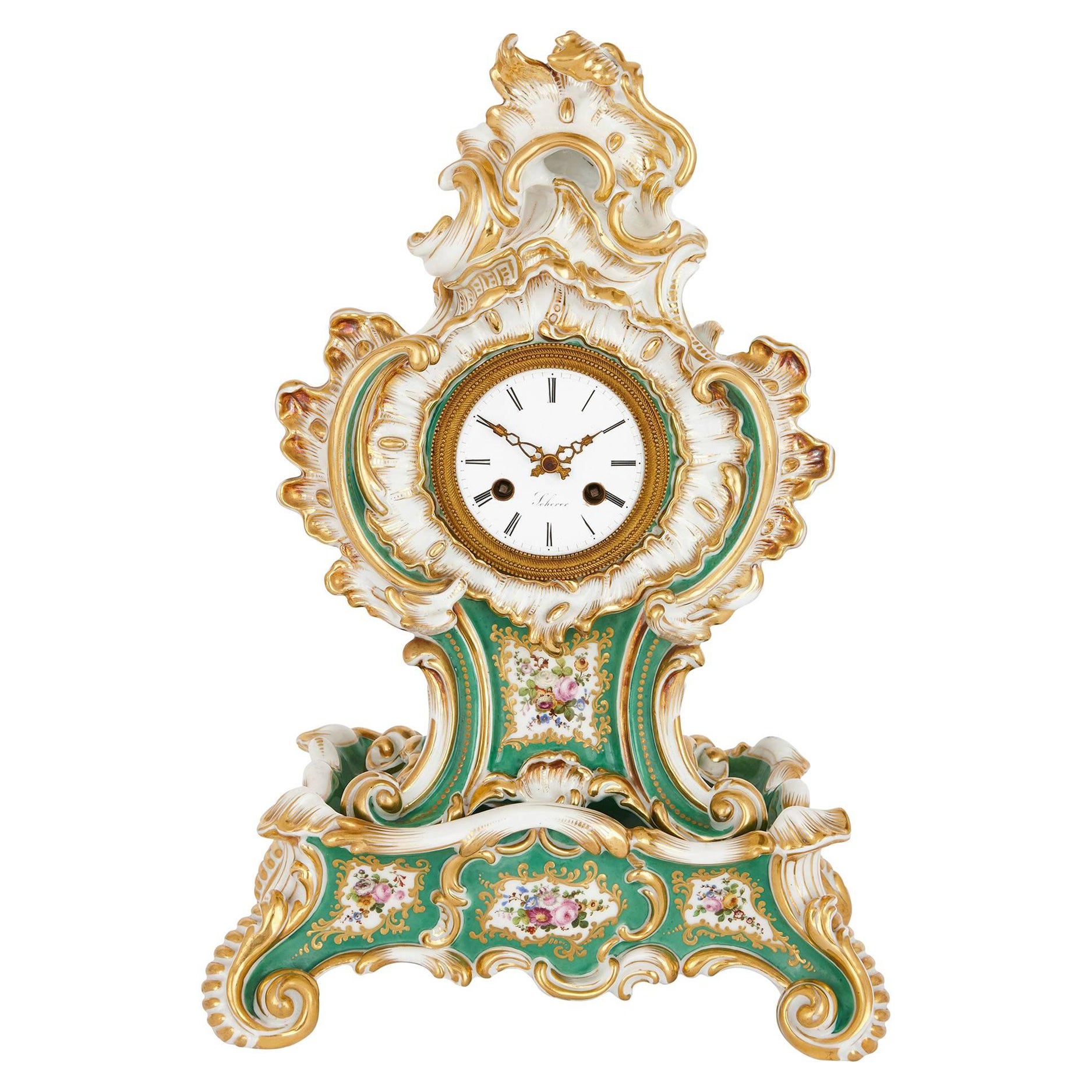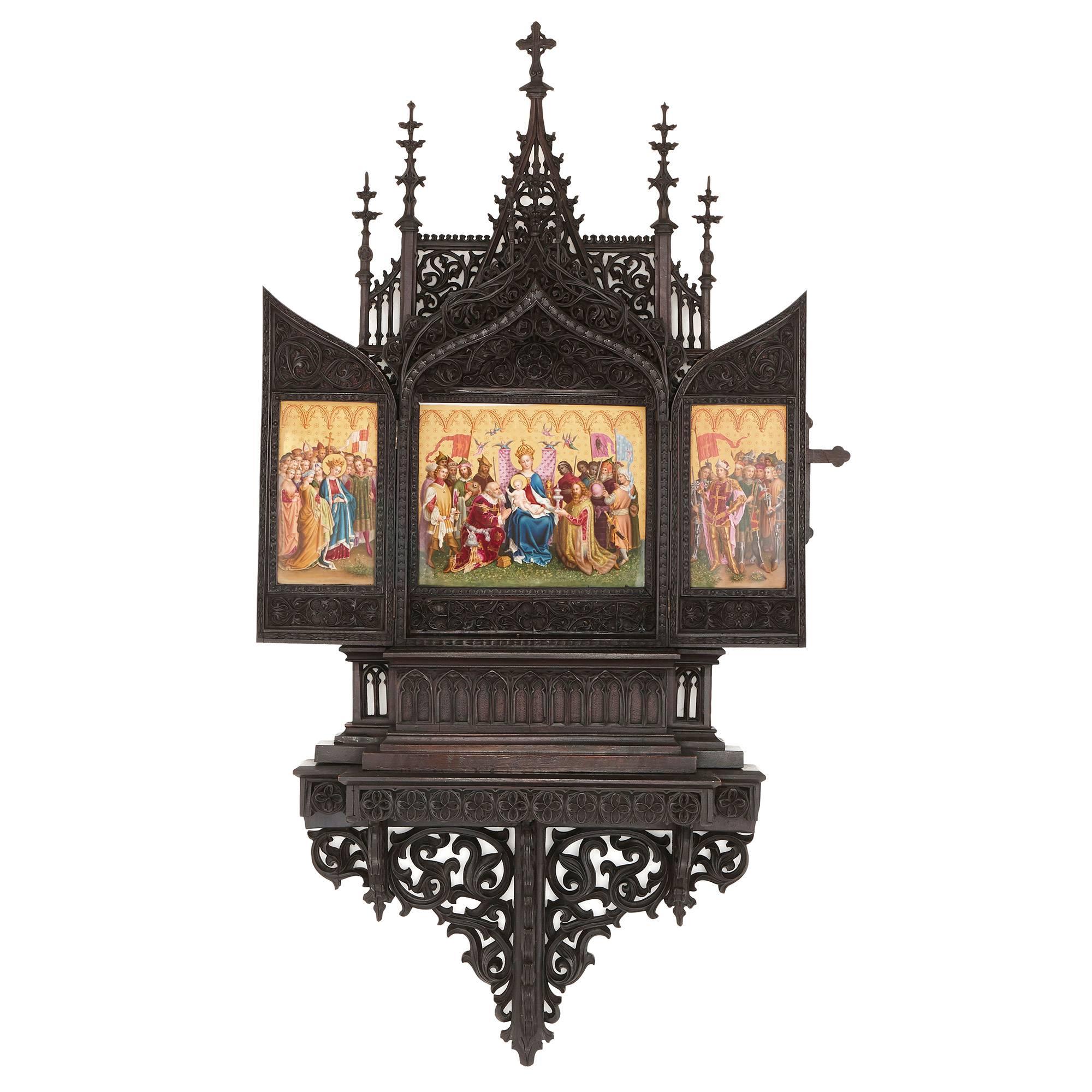Items Similar to Antique Gothic Revival Porcelain Clock by Dagoty & Honoré
Want more images or videos?
Request additional images or videos from the seller
1 of 9
Antique Gothic Revival Porcelain Clock by Dagoty & Honoré
About the Item
Antique Gothic Revival porcelain clock by Dagoty & Honoré
French, c. 1830
Measures: Height 51cm, width 25.5cm, depth 17cm
This beautiful Gothic Revival style porcelain clock was made by the prestigious French firm Dagoty and Honoré, founded by the esteemed porcelain makers Pierre-Louis Dagoty and Edouard Honoré. Dagoty and Honoré's factory in Paris was highly regarded in the early 19th century, and it came under the protection of the Empress Josephine, wife of Napoleon I of France. This green-coloured porcelain clock is one of the later and more accomplished works produced by Dagoty and Honoré, and is shaped to look like a Gothic cathedral, complete with spires, arches, and beautiful gilded highlights.
The clock dial is set into the centre of the cathedral, and around it there are windows, turrets, and arches in the Gothic style. A the bottom there is an arched doorway with a trompe l'oeil scene showing figures in a landscape. At either side of the doorway there are further trompe l'oeil panels depicting Biblical figures, made to look as if they are stained glass panels, and above there further painted windows to the front and sides.
The clock is marked 'Ancienne Maison Dagoty / Ed. Honoré A Paris / 4 Boulevard Poissoniere' to the underside.
- Creator:Dagoty (Maker)
- Dimensions:Height: 20.08 in (51 cm)Width: 10.04 in (25.5 cm)Depth: 6.7 in (17 cm)
- Style:Gothic Revival (Of the Period)
- Materials and Techniques:
- Place of Origin:
- Period:
- Date of Manufacture:circa 1830
- Condition:
- Seller Location:London, GB
- Reference Number:
About the Seller
5.0
Recognized Seller
These prestigious sellers are industry leaders and represent the highest echelon for item quality and design.
Gold Seller
These expertly vetted sellers are highly rated and consistently exceed customer expectations.
Established in 1975
1stDibs seller since 2012
361 sales on 1stDibs
Typical response time: 4 hours
Associations
The British Antique Dealers' AssociationInternational Confederation of Art and Antique Dealers' Associations
- ShippingRetrieving quote...Ships From: London, United Kingdom
- Return PolicyA return for this item may be initiated within 14 days of delivery.
More From This SellerView All
- French Porcelain Mantel Clock by Dagoty and HonoreBy Dagoty, Edouard Honoré 1Located in London, GBThis beautiful Gothic Revival style porcelain clock was made by the prestigious French firm Dagoty and Honore, founded by the esteemed porcelain makers Pierre-Louis Dagoty and Edouard Honore...Category
Antique Early 19th Century French Gothic Revival Mantel Clocks
MaterialsPorcelain
- Antique French Sevres Style Porcelain and Gilt Bronze Mantel ClockLocated in London, GBThe combination of sumptuous, lustrous ormolu and finely decorated Sevres style porcelain makes this mantel clock an exceptional piece. Built in France and retailed by the prestigiou...Category
Antique Mid-19th Century French Neoclassical Mantel Clocks
MaterialsBronze, Ormolu
- Porcelain Clock in the Louis XV Style by Jacob PetitBy Jacob PetitLocated in London, GBThis antique porcelain mantel clock demonstrates the 19th century nostalgia for the delicately elegant decorative arts under King Louis XV, also known as the Rococo style. Crafted by celebrated porcelain artist Jacob Petit, this exquisite clock is particularly notable for the way in which the porcelain has been shaped so as to give the clock such a whimsically free-spirited, scrolling shape. The clock is formed as a clock case upon a lower base, which are both decorated as a though a singular piece with green glaze on a white ground, accented with painted floral panels and extensive gilt highlights all over. The clock case, which is particularly exuberant in design, features a central, circular clock dial. The white enamelled dial is bordered with beaded ormolu, and features black Roman numerals and the inscription 'Scherer'- the name of the 19th century Parisian clock...Category
Antique 19th Century French Rococo Mantel Clocks
MaterialsPorcelain
- Gothic Revival Carved Oak and KPM Porcelain TriptychBy KPM PorcelainLocated in London, GBThe triptych comprises a trio of porcelain plaques, depicting the patron saints of the German city of Cologne (Köln) by the renowned Berlin manufacturer KPM (Konigliche Porzellan-Man...Category
Antique 19th Century German Gothic Revival Religious Items
MaterialsPorcelain, Oak
- Rococo Style Gilt Bronze and Sèvres Style Porcelain Clock GarnitureBy Manufacture Nationale de SèvresLocated in London, GBThis large and impressive clock garniture set consists of a central clock and a pair of flanking vases. The three pieces are extremely finely decorated with painted cartouches of fly...Category
Antique Late 19th Century French Rococo Mantel Clocks
MaterialsOrmolu
- Antique Three-Piece Meiji Period Japonisme Vase Clock SetLocated in London, GBAntique three-piece Meiji period Japonisme vase clock set French/Japanese, late 19th century Measures: Clock height 47cm, diameter 22cm Candelabra height 55cm, width 25cm, depth 2...Category
Antique Late 19th Century French Japonisme Mantel Clocks
MaterialsOrmolu
You May Also Like
- Meissen Porcelain Strut Mantel ClockBy Howell James & Co.Located in Norwich, GBA Meissen porcelain oval shaped Strut clock with two putti and well modelled trailing flowers and wreath decoration. (The back of the case at 12 o’clock carrying the crossed swords m...Category
Antique 1870s English Victorian Mantel Clocks
MaterialsPorcelain
- Sèvres Porcelain 'Jeweled' Three-Piece Clock Set by Raingo FrèresBy Raingo FrèresLocated in New York, NYA wonderful and important mid-19th century gilt bronze and turquoise sevres porcelain 'Jeweled' three-piece clock set. By Raingo Frères....Category
Antique Mid-19th Century French Belle Époque Clocks
MaterialsBronze
- Sèvres Porcelain Louis XVI Lyre Mantel Clock by Kinable, Dial by DubuissonBy Dubuisson, Dieudonné KinableLocated in Paris, FRDieudonné Kinable Enamel Dial Attributed to Dubuisson (1731-1815) Exceptional Porcelain Lyre Mantel Clock from the Royal Sèvres Porcelain Manufactory Paris, late Louis XVI period, circa 1785-1790 Height 62 cm; width 26 cm; depth 16 cm The round enamel dial, signed “Kinable”, indicates the hours in Roman numerals, the fifteen-minute intervals in Arabic numerals, the annual calendar and the signs of the Zodiac, by means of four hands, two of which are made of pierced gilt bronze, the two others in blued steel. The magnificent lyre-shaped case is made of “bleu nouveau” Sèvres porcelain and finely chased and gilt bronze. The bezel is made up of a gilt bronze twisted rope; the pendulum is adorned with brilliant-cut paste stones; the body of the lyre is adorned with gilt bronze beading and with laurel leaf and seed motifs, with two rosettes issuing floral and foliate swags. The clock is surmounted by a mask with radiating sunrays. The spreading foot is decorated with beading and twisted rope motifs and a leafy garland. The en-suite decorated oval base is raised upon four flattened ball feet. The Royal Sèvres Porcelain Factory produced the lyre clock model as of 1785. Four colours were offered: turquoise, green, pink and bleu nouveau. These exceptional clocks were made for the connoisseurs of the time. Louis XVI had a similar clock in his Salon des jeux in Versailles; its dial bore the signature of the clockmaker Courieult (this is almost certainly the example illustrated in P. Verlet, Les bronzes dorés français du XVIIIe siècle, Paris, 1999, p. 41). Kinable, however, was the clockmaker who purchased the greatest number of lyre cases from the factory, and he developed the model in the late 18th century. Among the porcelain lyre clocks signed by this brilliant horologer, one example is in the Victoria & Albert Museum in London (illustrated in H. Ottomeyer and P. Pröschel, Vergoldete Bronzen, Band I, Munich, 1986, p. 252, fig. 4.6.26). A second such clock is in the Royal British Collection (see C. Jagger, Royal Clocks, The British Monarchy & its Timekeepers 1300-1900, 1983, p. 130, fig. 176). Bibliography: M. Gay and A. Lemaire, “Les pendules lyre”, in Bulletin de l’Association nationale des Collectionneurs et Amateurs d’Horlogerie ancienne, Winter 1993, n° 68, p. 5-40. Dieudonné Kinable (active circa 1785-1810) One of the most important Parisian clockmakers of the late 18th century. His shop was located at n° 131 Palais Royal. He purchased a great number of lyre-type porcelain clock cases...Category
Antique 1780s French Louis XVI Mantel Clocks
MaterialsBronze
- Late 18th Century Dagoty French Porcelain Plate Cobalt Blue Children PlayingBy DagotyLocated in Katonah, NYWe are pleased to offer this extraordinary Dagoty porcelain plate showing children playing. The happy children are joined by their dog in a scene painted in grisaille. On this plate, the border of deep cobalt blue is lavishly gilded in a dramatic geometric pattern. As we see here, burnished gilt was another hallmark of Dagoty porcelains. The formal border juxtaposes the informal scene of the children at play with the geometric design. This type of contrast is typically French, and only the French made porcelains with this particular type of sophisticated contrast. Romanticism had a strong influence on the Dagoty porcelains of the last decade of the 18th century. Anecdotal scenes, indoor scenes, and scenes showing children's games replaced neoclassical subjects. The new themes were more human and had a much less rigid atmosphere. Condition: Excellent Diameter: 8 inches Price: $420 Background: The Paris retail shop was on the Boulevard Montmartre. The Dagoty factory made hard paste porcelain. The factory was in the Rue de Chevreuse, Paris, leased for nine years in 1800 by brothers Pierre-Louis (1771-1840) and Etienne-Jean-Baptiste Dagoty (1772-1800). Pierre-Louis became sole owner in 1804, and in 1807 the lease was renewed for a further nine years. The factory was under the protection of the Empress Josephine and supplied porcelain for Versailles. In 1816, Dagoty went into partnership with Edouard Honoré...Category
Antique Late 18th Century French Empire Decorative Dishes and Vide-Poche
MaterialsPorcelain
- Meissen Mantel Table Clock Bronze Porcelain Autumn Fall Kaendler, circa 1745By Johann Joachim KaendlerLocated in Vienna, ATMeissen gorgeous rococo mantel / table clock made of gilded / gilt bronze, excellently decorated with sculptured figurines made of porcelain. Manufactory: Meissen Hallmarked: Blue M...Category
Antique 1740s German Rococo Porcelain
MaterialsBrass, Bronze, Enamel
- Late 19th Century Gilt Bronze and Turquoise Sèvres Porcelain 'Jeweled' Clock SetBy Manufacture Nationale de SèvresLocated in New York, NYLate 19th century gilt bronze and turquoise Sèvres porcelain 'Jeweled' three-piece clock set The clock surmounted by a covered urn, the c...Category
Antique Late 19th Century French Belle Époque Mantel Clocks
MaterialsBronze
Recently Viewed
View AllMore Ways To Browse
Revival Painted
Gothic Revival Antique Furniture
Revival Gothic 19th
Gothic Panel
Green Clock
Antique Regard
Clock Beige
Antique Porcelain Clock
Antique Porcelain Clocks
Porcelain Clocks Antique
Porcelain Clocks Antique Clocks
Antique Clocks Porcelain
Porcelain Antique Clocks
Porcelain Antique Clock
Porcelain Clock Antique Clocks
Antique Gothic Revival
Porcelain French Clocks
French Porcelain Clock With





